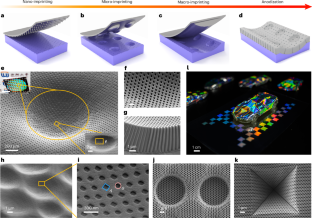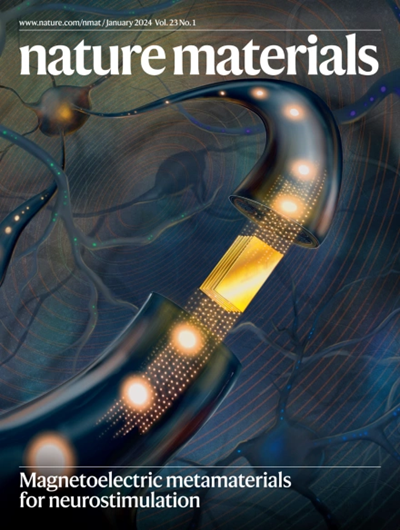Aluminium surface work hardening enables multi-scale 3D lithography
IF 38.5
1区 材料科学
Q1 CHEMISTRY, PHYSICAL
引用次数: 0
Abstract
Multi-scale structures are ubiquitous in biological systems. However, manufacturing man-made structures with controllable features spanning multiple length scales, particularly down to nanoscale features, is very challenging, which seriously impacts their collective properties. Here we introduce an aluminium-based three-dimensional lithography that combines sequential nano–micro–macro-imprinting and anodization of multi-scale anodic aluminium oxide templates to manufacture well-defined multi-scale structures, using various materials. The high-fidelity nano-patterns and micro-patterns were facilitated by the surface work hardening phenomenon, where the nano-patterns can be further fine-tailored by anodization to have high-aspect-ratio and tunable nano-holes. Based on the aluminium-based three-dimensional lithography, multi-scale materials across length scales of at least 107 orders of magnitude were precisely fabricated, including carbon, semiconductors and metals. We integrated pressure sensors and biosensors with superior and customizable performances by tailoring the multi-scale carbon networks on different length scales from nanofibres and micropyramids to macrodome arrays. This work provides a versatile technique for prototyping on-demand multi-scale structures and materials to explore desirable mechanical and physical properties. Aluminium surface work hardening is used to create structures that cover multiple length scales, featuring precise nano-features and adaptable material options. The potential is showcased through multi-scale carbon network sensors.


通过铝表面加工硬化实现多尺度 3D 光刻技术
多尺度结构在生物系统中无处不在。然而,制造具有跨越多个长度尺度的可控特征(尤其是纳米级特征)的人造结构非常具有挑战性,这严重影响了它们的集体特性。在此,我们介绍一种铝基三维光刻技术,该技术结合了多尺度阳极氧化铝模板的连续纳米-微米-宏观压印和阳极氧化,利用各种材料制造出定义明确的多尺度结构。表面加工硬化现象促进了高保真纳米图案和微图案的形成,纳米图案可通过阳极氧化进一步微调,以形成高宽比和可调的纳米孔。在铝基三维光刻技术的基础上,我们精确地制造出了长度尺度至少为 107 数量级的多尺度材料,包括碳、半导体和金属。我们通过定制不同长度尺度的多尺度碳网络(从纳米纤维、微金字塔到大圆顶阵列),集成了性能优越且可定制的压力传感器和生物传感器。这项工作为按需制作多尺度结构和材料原型以探索理想的机械和物理特性提供了一种通用技术。
本文章由计算机程序翻译,如有差异,请以英文原文为准。
求助全文
约1分钟内获得全文
求助全文
来源期刊

Nature Materials
工程技术-材料科学:综合
CiteScore
62.20
自引率
0.70%
发文量
221
审稿时长
3.2 months
期刊介绍:
Nature Materials is a monthly multi-disciplinary journal aimed at bringing together cutting-edge research across the entire spectrum of materials science and engineering. It covers all applied and fundamental aspects of the synthesis/processing, structure/composition, properties, and performance of materials. The journal recognizes that materials research has an increasing impact on classical disciplines such as physics, chemistry, and biology.
Additionally, Nature Materials provides a forum for the development of a common identity among materials scientists and encourages interdisciplinary collaboration. It takes an integrated and balanced approach to all areas of materials research, fostering the exchange of ideas between scientists involved in different disciplines.
Nature Materials is an invaluable resource for scientists in academia and industry who are active in discovering and developing materials and materials-related concepts. It offers engaging and informative papers of exceptional significance and quality, with the aim of influencing the development of society in the future.
文献相关原料
公司名称
产品信息
麦克林
H3BO3
麦克林
NiCl2·6H2O
阿拉丁
UA
阿拉丁
(NH4)6Mo7O24·4H2O
阿拉丁
CuCl2·2H2O
阿拉丁
NiSO4·6H2O
阿拉丁
1H,1H,2H,2H-perfluorodecyltrichlorosilane
 求助内容:
求助内容: 应助结果提醒方式:
应助结果提醒方式:


